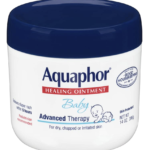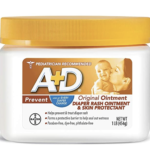Diaper Rash and Diaper Cream
Diaper rash
Diaper rashes are skin irritation in your child’s diaper area and they are a common affliction on babies. To avoid them you must use a suitable diaper cream.
Sometimes it is simply a irritated and red patch on your baby’s bottom. But sometimes it can be severe causing pain. In extreme cases the skin can bleed or become infected.
There are many different causes of diaper rash:
- Moisture: There is always moisture on your baby’s skin, causing potential irritation. Your baby’s bum is never completely dry even though diapers tries to wick moisture away from their skin.
- Stool: When your baby’s urine mixes with their stool, it causes a chemical reaction which creates ammonia. Ammonia is harsh on the skin and can cause irritation.
- Diarrhea: There is additional acid in your child’s diarrhea. This, combined with moisture and the chemical reaction when it mixes with urine, can cause diaper rash.
- Foods: The introduction of new foods into your baby’s diet changes the chemical composition of their stool and can irritate their skin.
- Chemicals: Disposable diapers have chemicals, perfumes and dyes to help trap the moisture and keep it from stinking. If your baby is getting diaper rashes, you may need to switch to a dye-free or natural diaper, or consider a switch to cloth.
- Detergents: If you use cloth diapers your baby can react to the detergent you use to wash them.
- Antibiotics: Antibiotics can kill healthy bacteria in your child’s digestive system. This can cause them to get diarrhea or also a yeast infection, both of which cause diaper rash.
Diaper cream
To prevent a rash or heal with an existing rash you can use diaper rash creams.
Diaper creams put a protective barrier between your baby’s bottom and potential irritants. Some also have soothing ingredients to help calm inflammation and heal irritation.
There are several types of diaper rash products on the market.
- Creams: Creams are water-based products. They are easily absorbed by the skin and easy to spread. Moreover, they are best for soothing irritated skin.
- Pastes: Pastes are thick products that protect your baby’s skin and also contain skin conditioners. These products can stain clothing and are not recommended with cloth diapers (unless you use a disposable liner) as they are difficult to get out of fabric.
- Ointments: Ointments are oil-based products. They are oily and greasy and sit on top of your child’s skin longer. They provide a good barrier between irritants and your child’s skin .
- Powders: While baby powder is advertised to absorb moisture on your baby’s bottom, it is not recommended for use as the fine powder becomes airborne and is easily inhaled by your little one. It is also often made up of corn starch, which will actually provide a food source for yeast and exacerbate the rash if your child has a yeast infection.
When choosing a diaper rash cream, it is important to consider the following:
Type of Rash
- If your baby has an irritated bottom, choose a traditional diaper cream or ointment.
- Yeast rash: you will need an antifungal cream because regular products will not help.
Cloth or Disposable Diapers
- Disposable diapers: if you use disposable diapers you don’t have to worry about diaper creams affecting their performance.
- Cloths: when using cloths, some ingredients in the creams or ointments can clog the fibers and make them less absorbent. If you use cloth, choose diaper creams without the ingredients petrolatum or zinc oxide. You may also want to use a disposable liner.
Ingredients
- Many diaper creams and ointments contain ingredients that have the potential to be irritants. If your child has a sensitivity, check the label for potential allergens such as: Lanolin, Mineral Oil, Coconut Oil, Beeswax and Sunflower Oil
Diaper Cream, Paste, or Ointment
Ointment
An ointment is the best option if you are using a product as a preventative measure against diaper rash.
 |
|
 |
|
Diaper cream
A cream may help soothe the skin if your baby has an existing rash.
 |
|
 |
|
Paste
If your baby has a particularly severe rash, use an ultra-thick paste to help both heal the skin and protect it against irritants.
 |
|

